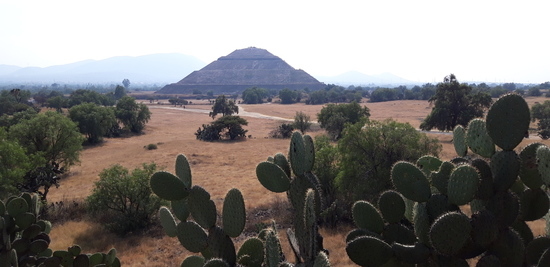Sonic Artefacts of Teotihuacan, Mexico (Horns, Trumpets and Pipes)
Abstract
:1. Introduction
2. Materials and Methods
2.1. Lip Reed Instruments
2.1.1. Shell Horns
2.1.2. Ceramic Horns
2.1.3. Ceramic Trumpets
2.2. Ceramic Duct Flutes
2.2.1. Pipes
Quadruple Flutes
Piston Whistles
3. Results
Supplementary Materials
Funding
Acknowledgments
Conflicts of Interest
Appendix A. List of the Institutions in Which the Discussed Sonic Artefacts Are Preserved
| 1 | Research carried out at the Research Laboratory of the Arizona State University and the Ceramoteca of the Zona de Monumentos Arqueológicos de Teotihuacán (2008); TVSM (Teotihuacan Virtual Sound Map), University of Huddersfield, UK (2019–2022). For more information, see Funding. |
| 2 | All institutions mentioned in this paper are identified with acronyms listed in the Appendix A. |
| 3 | The musical notes given here are calculated according to the Frequency to Musical Note Converter by Andrew Botros, Acoustics Lab of the School of Physics, University New South Wales, Sydney [8]. In the note name convention used, middle C is C4 and the note below it is B3. |
| 4 | The recordings of the sonic artefacts were made with KM184 Neumann microphones on a 4 channel digital recording device (1m of recording distance in an isolated cabin in museum environment). The recordings of the experimental models were made with DPA MMC4006 microphones on a digital recorder (1m of recording distance in studio environment). Excerpts of 250 ms taken from the middle part of each take were analyzed with the programs Audacity [9], Praat by Paul Boersma and David Weenink [10], and Spectrogram by Richard Horne [11]. For analysis of the sound pressure levels (1m of recording distance in studio environment), a calibrated measurement system consisting of a miniDSP UMIK-1 microphone and the freeware program Schallpegelmesser Pro by Markus Ziegler was used [12]. The sound propagation levels were estimated with the inverse square law, according to the online calculator by R. Nave [13]. |
| 5 | The partially fragmented bone trumpet has been excavated in the Teotihuacan-related site of Aljojuca, Puebla (EmS, Inv. 35.100017.A/B), see [16] (p. 33, 35, Figure 27). The identification of the bone as a human femur has been carried out by Mia Broné in 2019. In size and shape, particularly the length, form of the mouthpiece and the bore, the instrument presents a comparable morphology than the ceramic trumpets described below and therefore also comparable acoustic parameters. |
| 6 | |
| 7 | For the specimen preserved in the MNA, see [4] (pp. 188–189, Figures 11–15); a further specimen said to be from Teotihuacan belongs to the Diego Rivera collection (MA). |
| 8 | |
| 9 | MNA (Inv. 10-0009260), see [20]. |
| 10 | |
| 11 | Finds from the TMP (RL-ASU); Las Palmas and Xolalpan (EmS, Inv. 32.08.0268; 32.08.1962; 32.08.2363; 32.08.6598, the latter two specimens presenting rests of Maya blue pigmentation and are possibly imported from the Maya area). |
| 12 | The effect is a form of sideband distortion or intermodulation distortion (IMD), which is the result of two interacting signals generated by the shell horn and the mouthpiece, functioning as two separate acoustic entities [25]. |
| 13 | The self-sounding condition is repeatedly shown in a series of depictions and possibly reflects the belief in a sort of animisation or deification of the instruments, which is also supported by the employment of tassel headdresses composed of the plumes of the quetzal bird and the occasional depiction of a numinous being emerging out of the bell, possibly representing the Teotihuacan God of Music [4,21]. |
| 14 | |
| 15 | More than 600 finds of trumpets in fragmented condition are preserved in the following institutions: from the TMP (RL-ASU) and excavations in La Ventilla, among others (C-ZMAT); Xalla and the Tunnels CV and CP (IIA-UNAM); Las Palmas and Xolalpan (EmS). For find distribution maps of the mouthpieces and tube fragments, established on the basis of the data from the RL-ASU and C-ZMAT, see [6] (pp. 132–134, Figures 2.58–2.60). |
| 16 | The particular form of cup-shaped bells can be compared to the Greek salpinges, for ancient brass instruments. In acoustic terms, the flared section of the bell assists in giving a range of wave impedances, which are more-closely in line with a natural harmonic series. The cup shape of the bell end, in turn, increases the end impedance discontinuity (giving a greater impedance change than if the flare had continued to the end of the bell yard), which means that more of the standing wave in the tube is reflected. On the other hand, less of the standing wave energy escapes into the environment, making the instrument quieter. The cup-shaped bell also changes the timbre of the instrument, making it less strident [30]. |
| 17 | The forms possibly refer to comparable instruments made from reed or comparable plant material, which did not survive in the archaeological record. |
| 18 | |
| 19 | Finds from the TMP (RL-ASU), see [6] (pp. 44–46, Figures 2.10–2.12); one fragment preserved in the MNA (Inv. 9-22259). |
| 20 | Finds from the TMP (RL-ASU); two finds from Las Palmas and Xolalpan (EmS, Inv. 32.08.6914; 32.08.6911). |
| 21 | For the flutes possibly originating from the Gulf Coast, one has been published by Séjourné [26] (p. 235, Figure 125) and one fragment is known from a private collection (EmG, Inv. 2013.04.0338); for unpublished fragments of Aztec flutes: finds from the TMP (RL-ASU), see [6] (pp. 30–31, 40, 49, Abb. 2.6, Table 2.2); from Las Palmas and Tlamimilolpan (EmS, Inv. 32.08.2994; 35.08.0194; 35.08.0595); from the Tunnels CP and CV (IIA-UNAM); and further finds stored in the MNA (Inv. 10-150381; 9-4576). |
| 22 | An early publication of these “Aztec flutes” was made by Wilson [33] (pp. 606–607, Figures 252–253). Comparable unpublished finds are stored, for example, in the Met. |
| 23 | This particular configuration is unusual if compared to other aperture forms applied in the ceramic fipple flutes from Mesoamerica, conventionally presenting rectangular or quadratic and less frequently oval, circular or semicircular shapes. |
| 24 | The miniatures are produced in the form of small ceramic plaques with a flat inferior side and the superior side simulating the instrument in relief, frequently simulating the fingerholes, apertures, and decoration [5] (pp. 76–81: Figures 6–8), [26] (pp. 237–238, 240, Figures 127–129), [34] (p. 379, Figure 268), [35] (p. 13, Table 4), [36] (p. 46, Photo 129), [36] (p. 3, Photo 130). A series of finds is stored in the RL-ASU and the C-ZMAT; one further find in the MNA (the latter without inventory number). |
| 25 | Documented for the project are 40 fragmented finds from the TMP (RL-ASU), for a selection see [5] (pp. 74–76, Figure 5); finds from Atetelco, La Ventilla and other excavation sites (C-ZMAT; Inv. 10-600289; 10-599898; Elem. 19897; 57888; further finds without inventory no., for a selection see [5] (p. 71, 74–76, Figure 2); one find in the MA (Inv. 45540); finds from Zacuala, Yayahuala and Tetitla, see [26] (p. 236, Figure 126), [38] (p. 106, Figure 83D,E); two finds from Teopancazco [7] (p. 202, 205, Figures 4.47–4.48). A distribution map, based on the finds stored in the RL-ASU and the C-ZMAT, has been compiled by Arndt [5] (p. 83, Figure 9). |
| 26 | Several fragmented specimen: one semicomplete instrument (MNA), see [5] (pp. 85–86, Figure 10), [38] (p. 194), and a mouthpiece from the Joseph Hellmer collection, see [5] (p. 86, Figure 11), [31] (p. 48), [39] (p. 191), these finds ascribed to the Gulf Coast, but according to organological and iconographical features certainly originating from Teotihuacan; whistle showing a quadruple flute player of uncertain provenance, possibly from the Gulf Coast, see [5] (p. 88, Figure 12), [40] (Figure 132); fragmented mouthpieces from Monte Albán, Oaxaca, see [5] (pp. 86–90, Figure 11), [41] (pp. 631–632, Figure 3), [42] (p. 170, Figure 5.60); mouthpiece fragment from Río Seco, Escuintla, Guatemala [42] (p. 261, 270, Figure 10). |
| 27 | Finds from the ITESM collection (No. 3648 1/2 and 2/2), see [5] (pp. 93–94, Figure 15). According to Martí [39] (p. 195), the sonic artefacts are from Colima. The West Mexican origin is also supported by organological features, such as the quadratic form of the windows and the attachment of side frames. |
| 28 | Two finds from Jaina, Campeche; further finds from Baking Pot, Belize [5] (pp. 90–93. Figures 13–14). |
| 29 | |
| 30 |
References
- Both, A.A.; Padrón, O. The Quadruple Flutes of Teotihuacan, Mexico. Heritage Special Issue “Sonic Heritage: Sound and Multisensory Interactions in Immersive Virtual Reality and Cultural Heritage”. Eva, P., Angela, B., Eds.; in preparation.
- Both, A.A. Teotihuacan Whistling Vessels. J. Anthropol. Archaeol. Special Issue. Scullin, D., Herrera, A., Eds.; submitted, peer-reviewed.
- Both, A.A. Los artefactos sonoros de Teotihuacan, México (Percusión). Rev. De Arqueol. Am. 2021, 39. in preparation. [Google Scholar]
- Both, A.A. Las trompetas de caracol marino de Teotihuacan. In Ecos Del Pasado: Los Moluscos Arqueológicos de México; Colección Científica, 572; Diez, L.S., Castro, A.V., Eds.; INAH: Mexico City, Mexico, 2010; pp. 183–196. [Google Scholar]
- Arndt, D.J. The Quadruple Flutes of Teotihuacan Resurfaced. In Flower World—Music Archaeology of the Americas; Stöckli, M., Howell, M., Eds.; Ekho Verlag: Berlin, Germany, 2014; Volume 3, pp. 67–100. [Google Scholar]
- Arndt, D.J. Klangartefakte Im Archäologischen Befund Teotihuacans. Unpublished Master‘s Thesis, Philosophische Fakultät, Rheinische Friedrich-Wilhelms-Universität Bonn, Bonn, Germany, 2015. [Google Scholar]
- Zalaquett, F.; Espino, D.S.; Vázquez, V. Instrumentos sonoros procedentes de las excavaciones de Teopancazco. In Teopancazco Como Centro de Barrio Multiétnico de Teotihuacan: Los Sectores Funcionales Y El Intercambio a Larga Distancia; Linda, R.M., Ed.; UNAM: Mexico City, Mexico, 2018; pp. 181–212. [Google Scholar]
- Frequency to Musical Note Converter. Available online: https://newt.phys.unsw.edu.au/music/note/ (accessed on 21 March 2021).
- Audacity. Available online: http://audacityteam.org/ (accessed on 21 March 2021).
- Praat. Available online: www.praat.org (accessed on 21 March 2021).
- Spectrogram. Available online: http://db0fhn.efi.fh-nuernberg.de/~dg8ygz/voicetools/ (accessed on 21 March 2021).
- Schallpegelmesser Pro. Available online: https://spaichinger-schallpegelmesser.de/index.html (accessed on 21 March 2021).
- Estimating Sound Levels with the Inverse Square Law. Available online: http://hyperphysics.phy-astr.gsu.edu/hbase/Acoustic/isprob2.html (accessed on 21 March 2021).
- Both, A.A. Sonic Artefacts of Teotihuacan, Mexico (Vessel Flutes). Acoustics Special Issue “Acoustics, Soundscapes and Sounds as Intangible Heritage”. Álvarez-Morales, L., Díaz-Andreu, M., Eds.; in preparation.
- Both, A.A. Music Archaeology: Some Methodological and Theoretical Considerations. Yearb. Tradit. Music 2009, 41, 1–11. [Google Scholar]
- Linné, S. Mexican Highland Cultures: Archaeological Researches at Teotihuacan, Culpulalpan and Chalchicomula in 1934/35; New Series, No. 7; Hakan Ohlssons Boktryckeri: Lund, Sweden; The Ethnographical Museum of Sweden (Statens Etnografiska Museum): Stockholm, Sweden, 1942. [Google Scholar]
- Grube, N.; Gómez, C.S. Preliminary Iconographic Study of the Shell Trumpets from the Tlalocan Project. In Teotihuacan: City of Water, City of Fire, 248. Exhibition Catalogue; De Young Museum: San Francisco, CA, USA; Los Angeles County Museum of Art: Los Angeles, CA, USA; University of California Press: Berkeley, CA, USA, 2017. [Google Scholar]
- Castro, A.V.; Bautista, C.P.; Roldán, G.P. Bearbeitete Muscheln und Knochen in Teotihuacan. In Teotihuacan: Geheimsnisvolle Pyramidenstadt; Exhibition Catalogue, Museé du Quai Branly, Eds.; Somogy Éditions D’art/Museé Du Quai Branly: Paris, France, 2009; pp. 147–151. [Google Scholar]
- Caracol. Available online: https://www.mediateca.inah.gob.mx/islandora_74/islandora/object/objetoprehispanico%3A24277 (accessed on 21 March 2021).
- Caracol. Available online: https://www.mediateca.inah.gob.mx/islandora_74/islandora/object/objetoprehispanico%3A18573 (accessed on 21 March 2021).
- Both, A.A. Shell Trumpets in Mesoamerica: Music-Archaeological Evidence and Living Tradition. In Studien zur Musikarchäologie; Hickmann, E., Eichmann, R., Eds.; VLM: Rahden, Germany, 2004; Volume 4, pp. 261–278. [Google Scholar]
- Herrera, A.; Hurtado, E.; Pablo, J.; Moncada, G.; Gregorio, J.; Morris, A. Arqueomusicología de las trompetas de caracol andinas de concha y cerámica. In Flower World—Music Archaeology of the Americas; Stöckli, M., Howell, M., Eds.; Ekho Verlag: Berlin, Germany, 2014; Volume 3, pp. 141–168. [Google Scholar]
- Kolar, M.; Rick, J.W.; Cook, P.R.; Abel, J.S. Ancient Putus Contextualized: Integrative Archaeoacoustics at Chavín de Huántar, Peru. In Flower World—Music Archaeology of the Americas; Stöckli, M., Both, A.A., Eds.; Ekho Verlag: Berlin, Germany, 2012; Volume 1, pp. 23–54. [Google Scholar]
- Both, A.A. Nuevos datos acerca de los cuernos de caracol de Teotihuacan, México. In Avances Y Perspectivas en la Investigación de Los Materiales Arqueológicos de Concha; Castro, A.V., Ed.; in preparation.
- Till, R.; Department of Music and Drama, University of Huddersfield, Huddersfield HD1 3DH, UK. Personal communication.
- Séjourné, L. Arqueología de Teotihuacan: La Cerámica; Fondo de Cutura Económico: Mexico City, Mexico; Buenos Aires, Argentina, 1966. [Google Scholar]
- MqB (Museé du quai Branly) (Ed.) Teotihuacan: Geheimsnisvolle Pyramidenstadt; Exhibition Catalogue; Somogy Éditions D’art/Museé du Quai Branly: Paris, France, 2009. [Google Scholar]
- Hickmann, E. Klänge Altamerikas: Musikinstrumente in Kunst und Kult; Publikationen der Reiss-Engelhorn-Museen; Wissenschaftliche Buchgesellschaft: Darmstadt, Germany, 2007; Volume 25. [Google Scholar]
- Gudemos, M. Trompetas Andinas Prehispánicas: Tradiciones Constructivas Y Relaciones de Poder. Anales Del Museo de América. 2009, Volume XVII, pp. 184–224. Available online: file:///C:/Users/Intel/Downloads/Dialnet-TrompetasAndinasPrehispanicasTradicionesConstructi-3661098.pdf (accessed on 21 March 2021).
- Holmes, P.; Senior Acoustics and AV Consultant at Inhabit Group Shanghai. Personal communication.
- Martí, S. Alt-Amerika; Musikgeschichte in Bildern, Musik des Altertums, Lieferung 7; VEB Deutscher Verlag für Musik: Leipzig, Germany, 1970; Volume 2. [Google Scholar]
- Pasztory, E. The Murals of Tepantitla, Teotihuacan; Garland: New York, NY, USA, 1976. [Google Scholar]
- Wilson, T. Prehistoric Art; or the Origin of Art as Manifested in the Works of Prehistoric Man; Government Printing Office: Washington, DC, USA, 1898.
- Manzanilla, L. Anatomía De Un Conjunto Residencial Teotihuacano en Oztayahualco, Vol 1: Las Excavaciones; UNAM: Mexico City, Mexico, 1993. [Google Scholar]
- Sugiyama, S. Censer Symbolism and the State Polity in Teotihuacán. 2002. Available online: http://www.famsi.org/reports/97050/97050Sugiyama01Text.pdf (accessed on 21 March 2021).
- Sugiyama, S. Censer Symbolism and the State Polity in Teotihuacán, III. Anthropomorphic Attributes of Deities and Characters. 2002. Available online: http://www.famsi.org/reports/97050/97050Sugiyama01Images3.pdf (accessed on 21 March 2021).
- Sugiyama, S. Censer Symbolism and the State Polity in Teotihuacán, IV. Other Motifs: Different Representations and Symbols. 2002. Available online: http://www.famsi.org/reports/97050/97050Sugiyama01Images4.pdf (accessed on 21 March 2021).
- Séjourné, L. Un Palacio en la Ciudad de los Dioses [Teotihuacán]; INAH: Mexico City, Mexico, 1959. [Google Scholar]
- Martí, S. Instrumentos Musicales Precortesianos; INAH: Mexico City, Mexico, 1968. [Google Scholar]
- Goldstein, M.M. Ceremonial Sculpture of Ancient Veracruz; Hillwood Art Gallery, Long Island University: New York, NY, USA, 1987. [Google Scholar]
- Winter, M.; López, C.M.; Torres, A.H.M. Monte Albán y Teotihuacan: Política e ideología. In Ideología Y Política a Través de Materiales, Imágenes Y Símbolos; Memoria de la Primera Mesa Redonda de Teotihuacan; Ruíz Gallut, M.E., Ed.; UNAM/INAH: Mexico City, Mexico, 2002; pp. 627–644. [Google Scholar]
- Santiago, G.S. Las Culturas Musicales del Oaxaca Prehispánico: Una Perspectiva Desde la Etapa de las Aldeas Hasta las Ciudades-Estado (1400 c.C.–1521 d.C.). Unpublished Ph.D. Thesis, Facultad de Filosofía y Letras, Instituto de Investigaciones Estéticas, UNAM, Mexico City, Mexico, 2016. [Google Scholar]
- De Monterroso, M.I.; Matthias, S. Tierra, viento y fuego: Las figurillas y objetos sonoros de Río Seco (La Gomera, Escuintla). In XXVIII Simposio de Investigaciones Arqueológicas en Guatemala; Arroyo, B., Salinas, L.M., Paiz, L., Eds.; Museo Nacional de Arqueología y Etnología: Guatemala City, Guatemala, 2015; pp. 255–270. [Google Scholar]
- Castellanos, P. Horizontes de la Música Precortesiana; Fondo de Cultura Económica: Mexico City, Mexico, 1970. [Google Scholar]
- Martí, S. Instrumentos Musicales Precortesianos; INA: Mexico City, Mexico, 1955. [Google Scholar]
- Castellengo, M. Écoute Musicale et Acoustique; Avec 420 Sons et Leurs Sonagrammes Décryptés; Eyrolles: Paris, France, 2015. [Google Scholar]
- Brohée, J.-F. Pre-Columbian Music(s) of Mesoamerica and Central America: Interdisciplinary Approach through in-Depth Investigation of the Sonorous Artifacts from the MAH and MIM Collections (Brussels). Ph.D. Thesis, Université Libre de Bruxelles, Brussels, Belgium. in preparation.





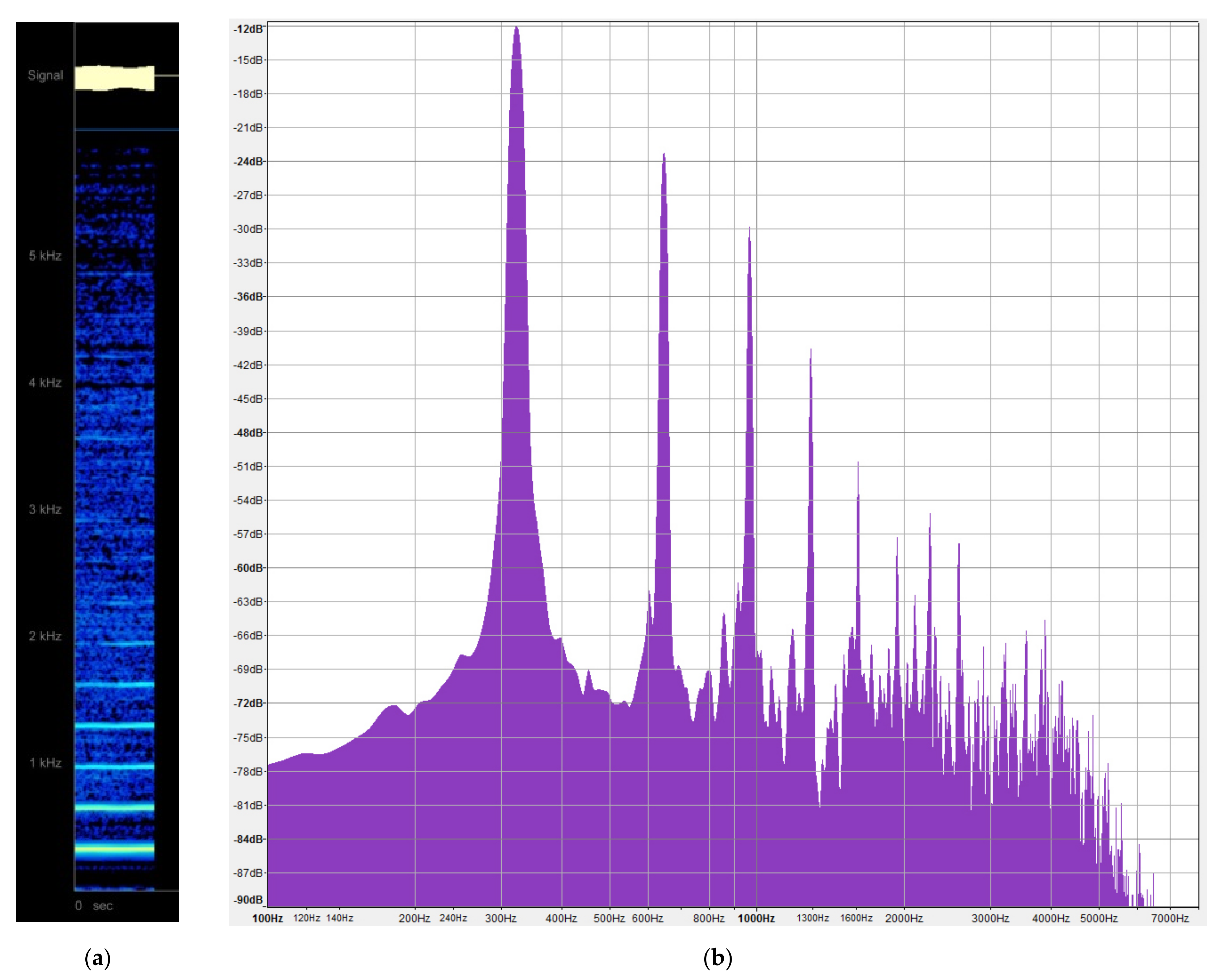

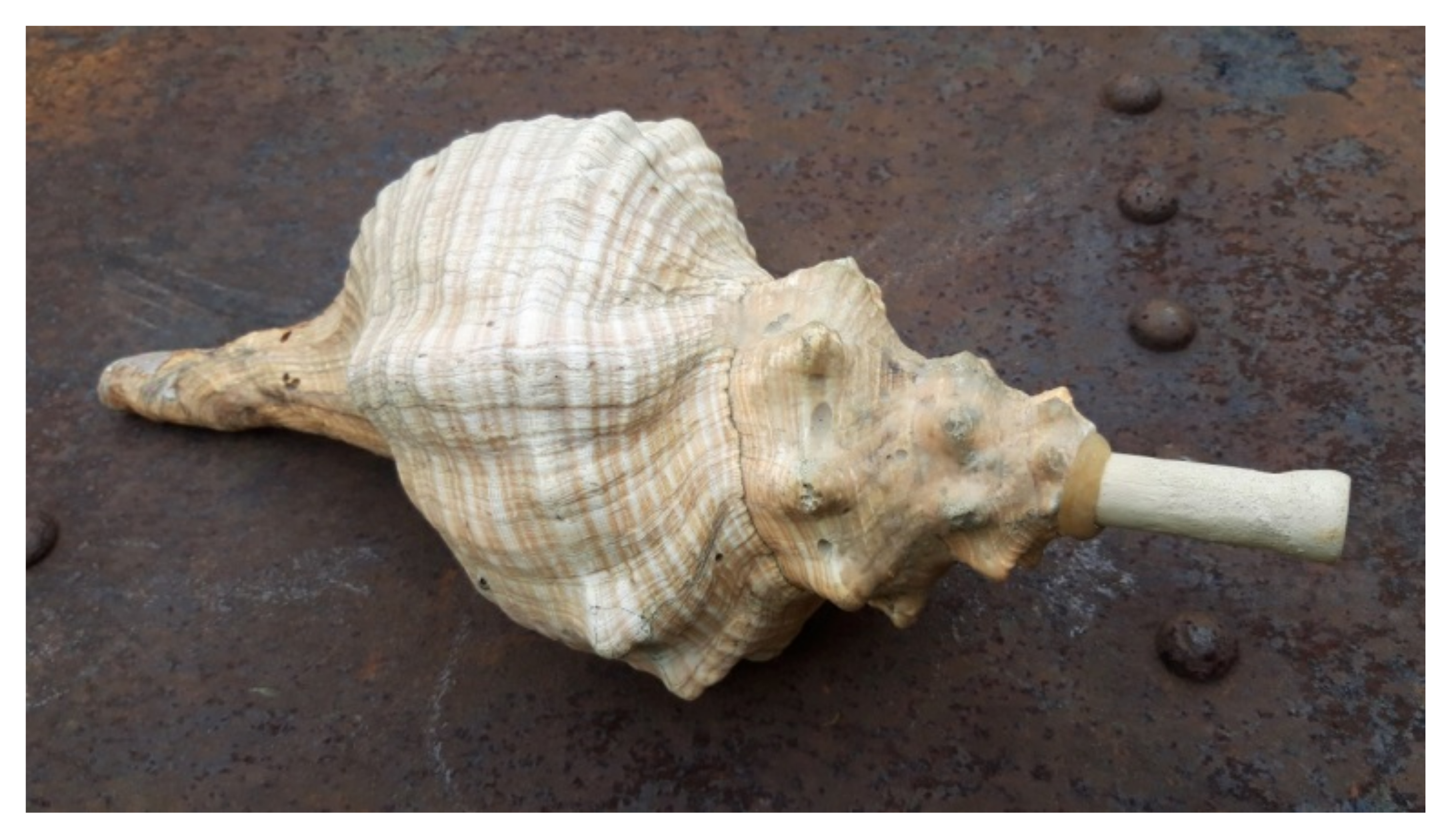





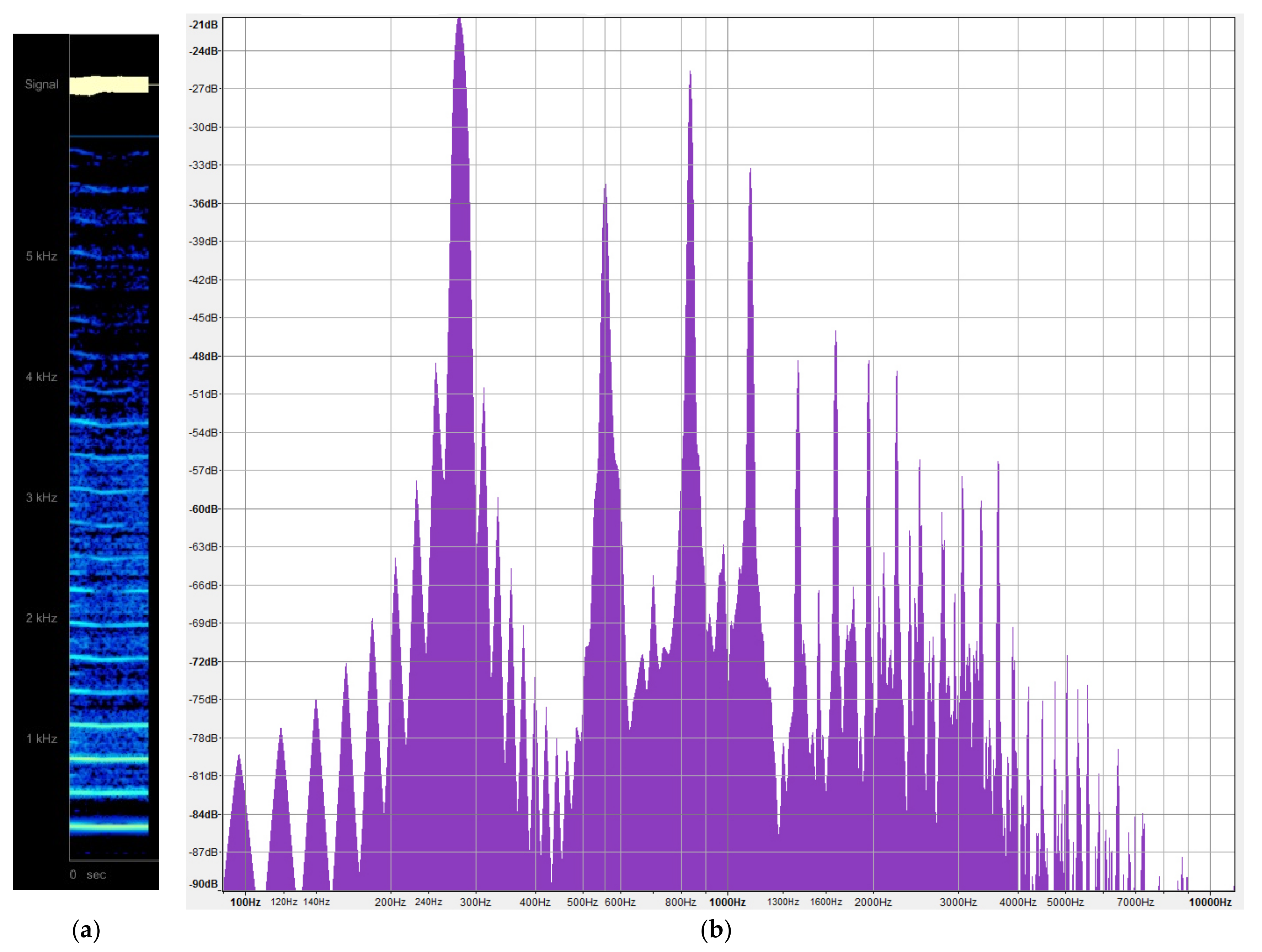


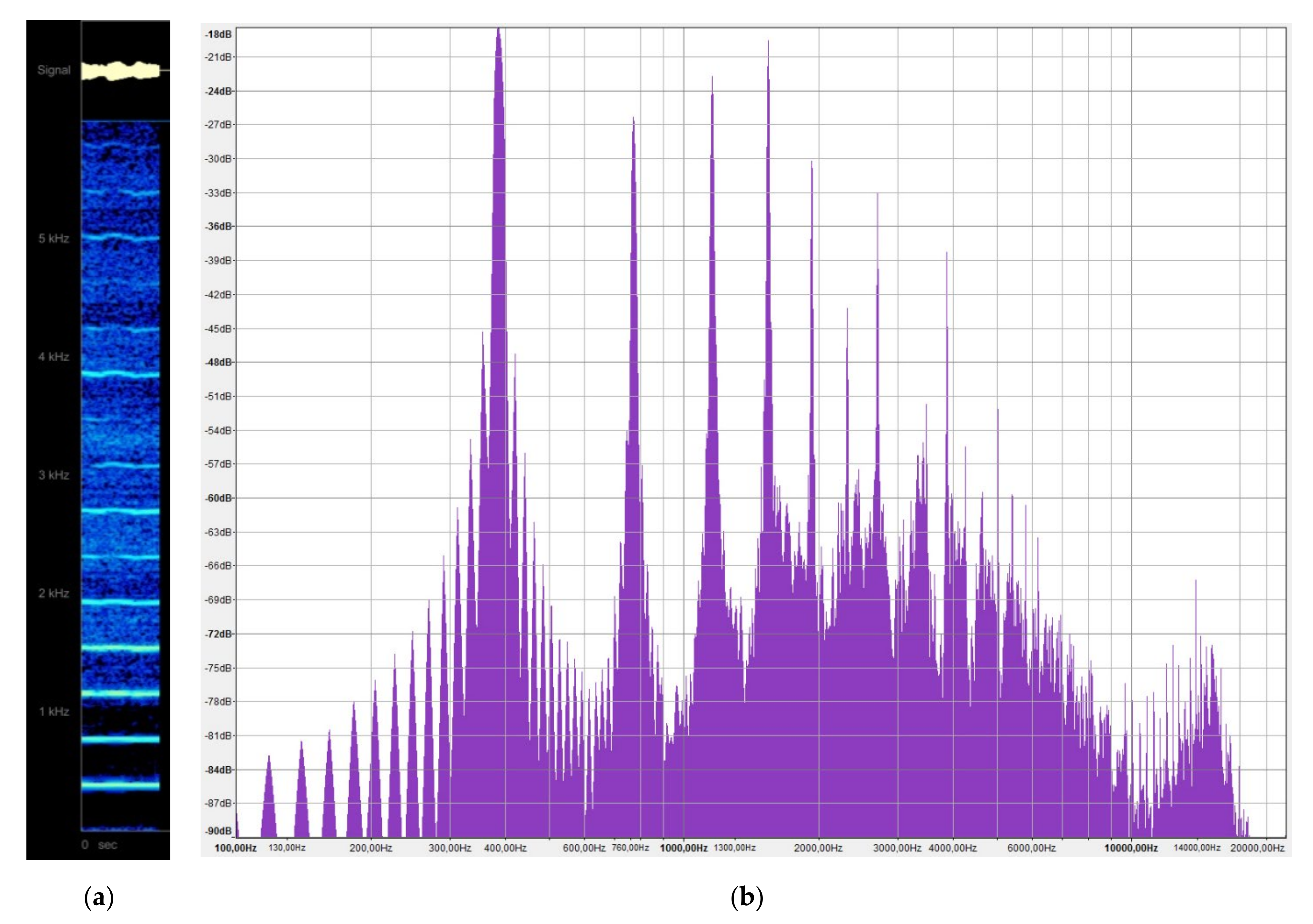
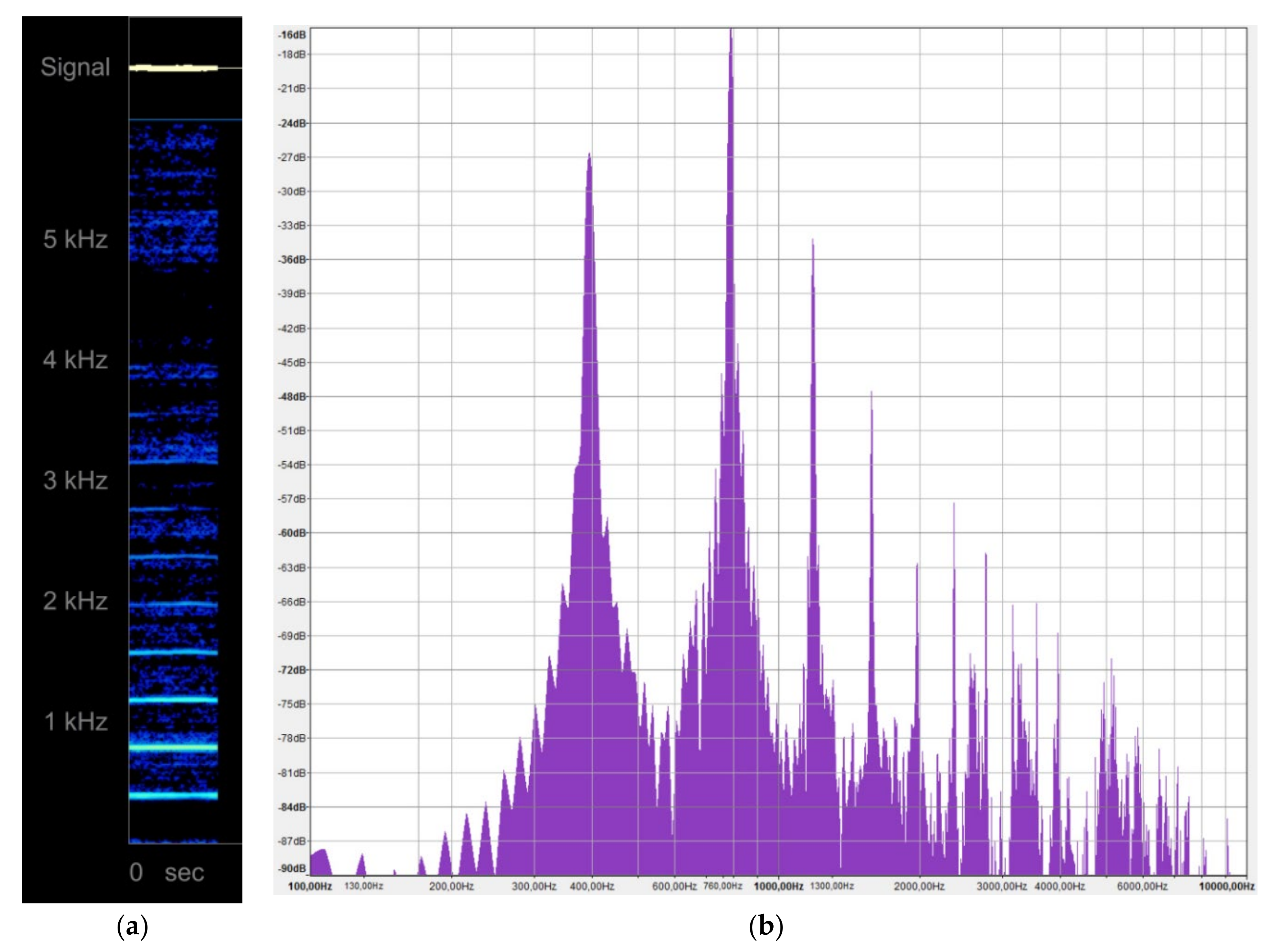




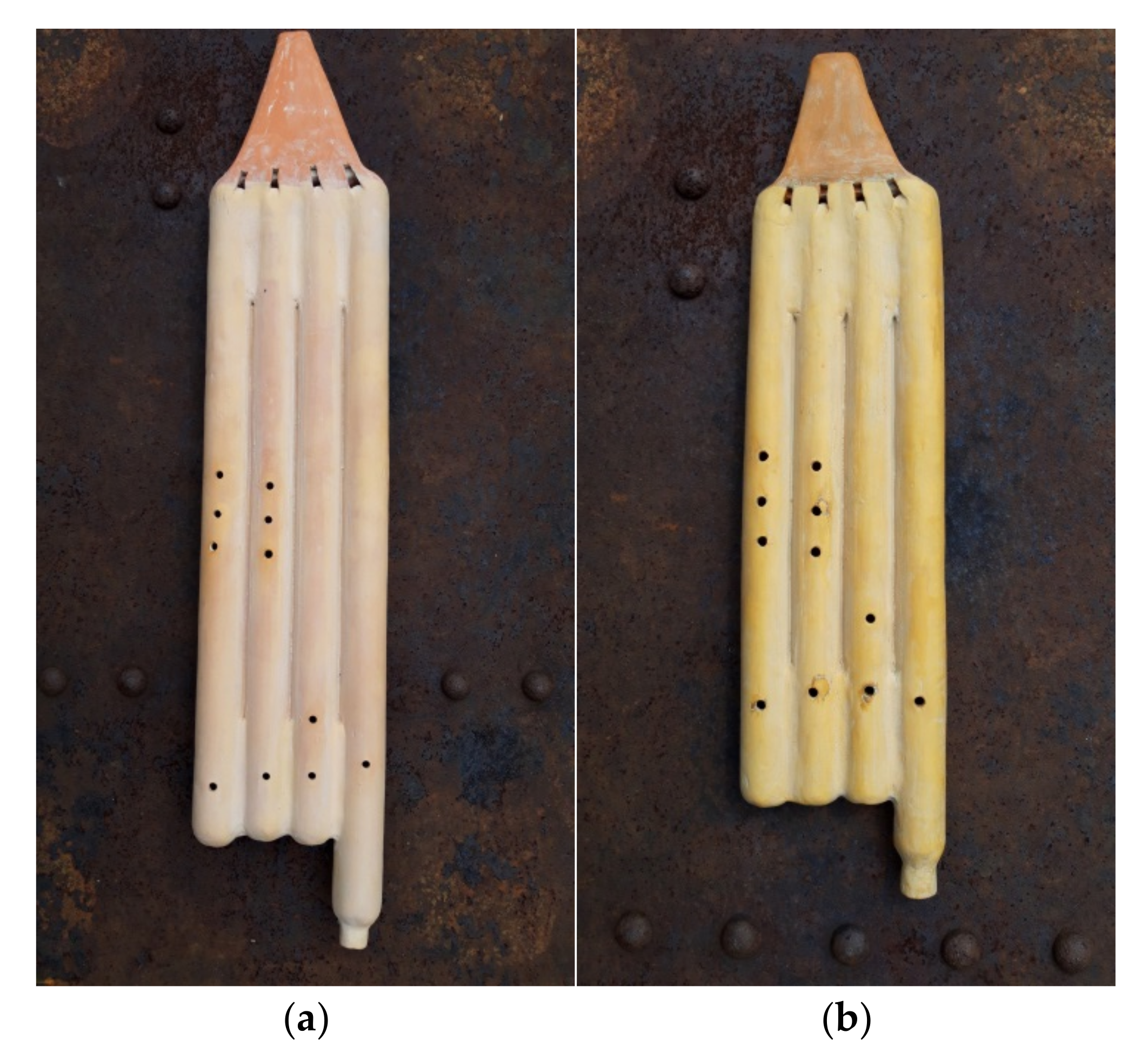

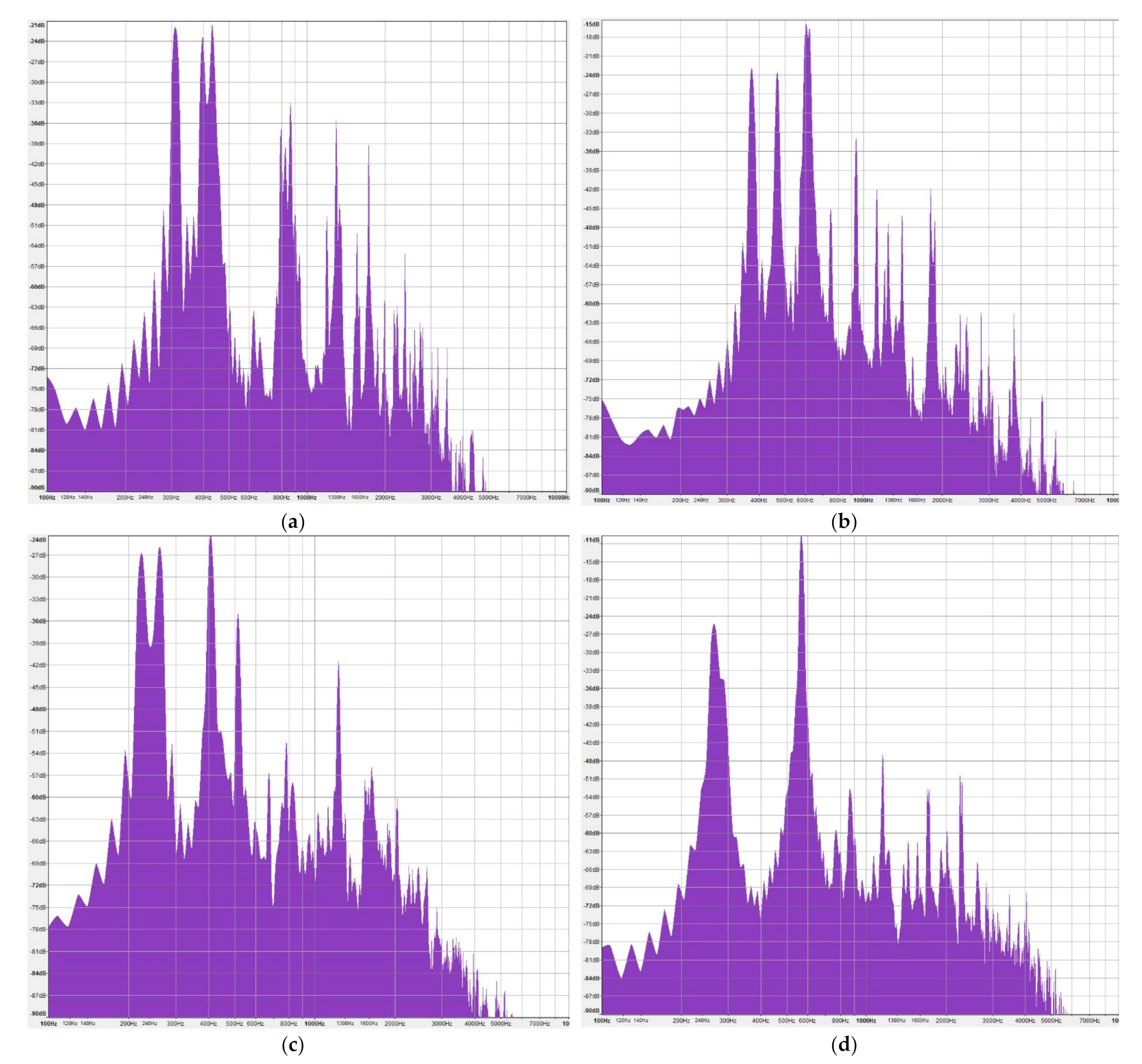
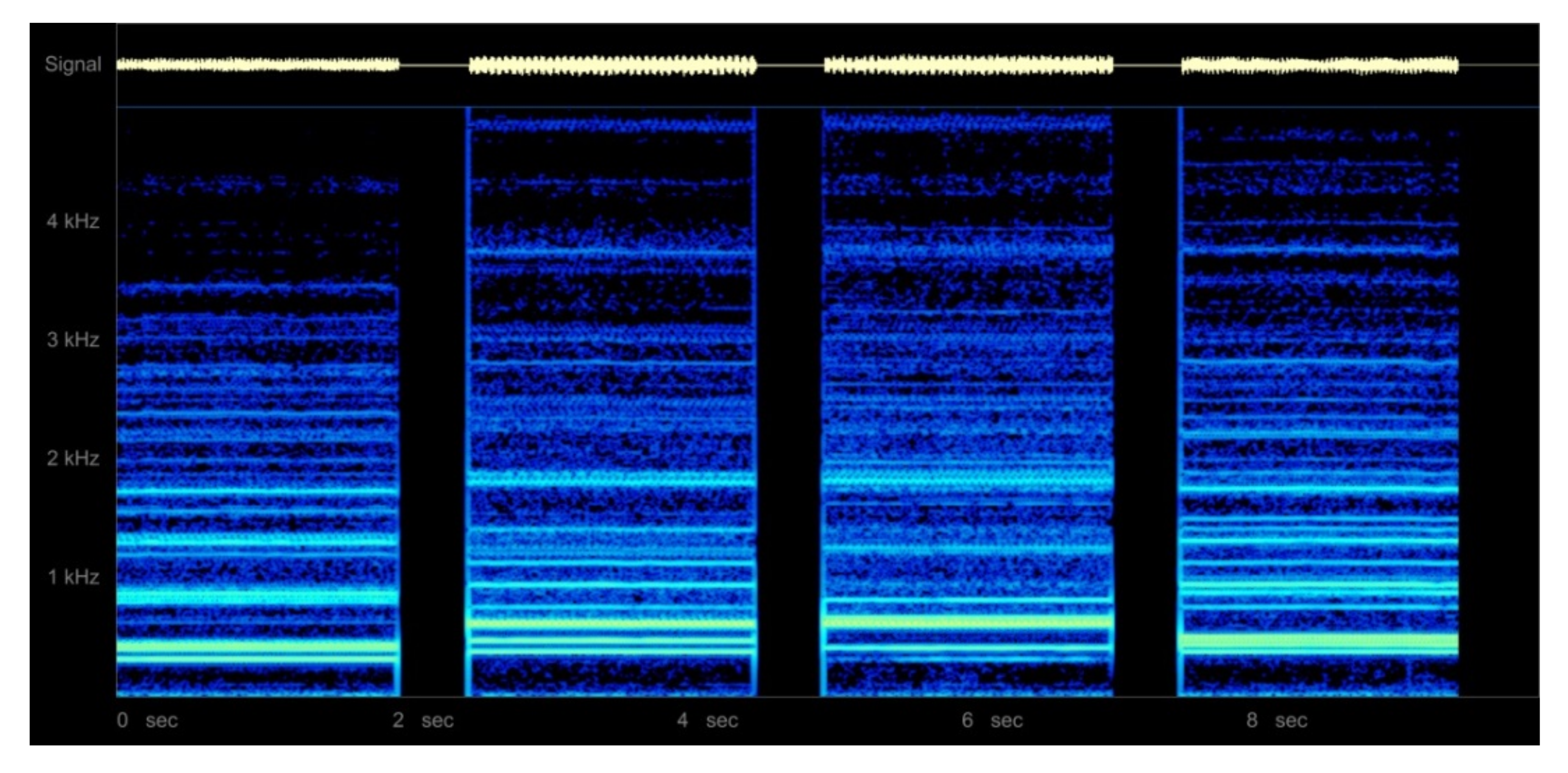
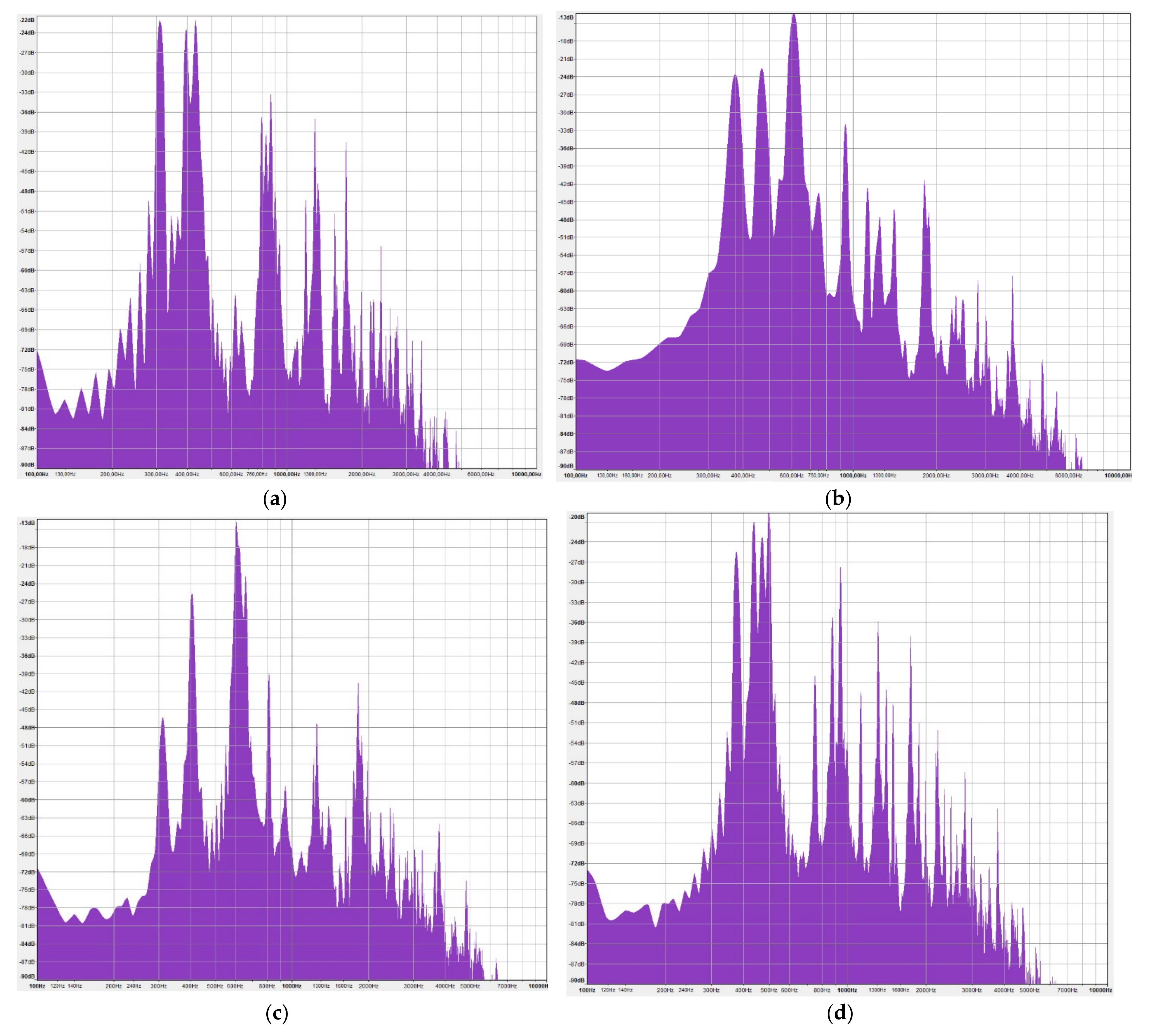
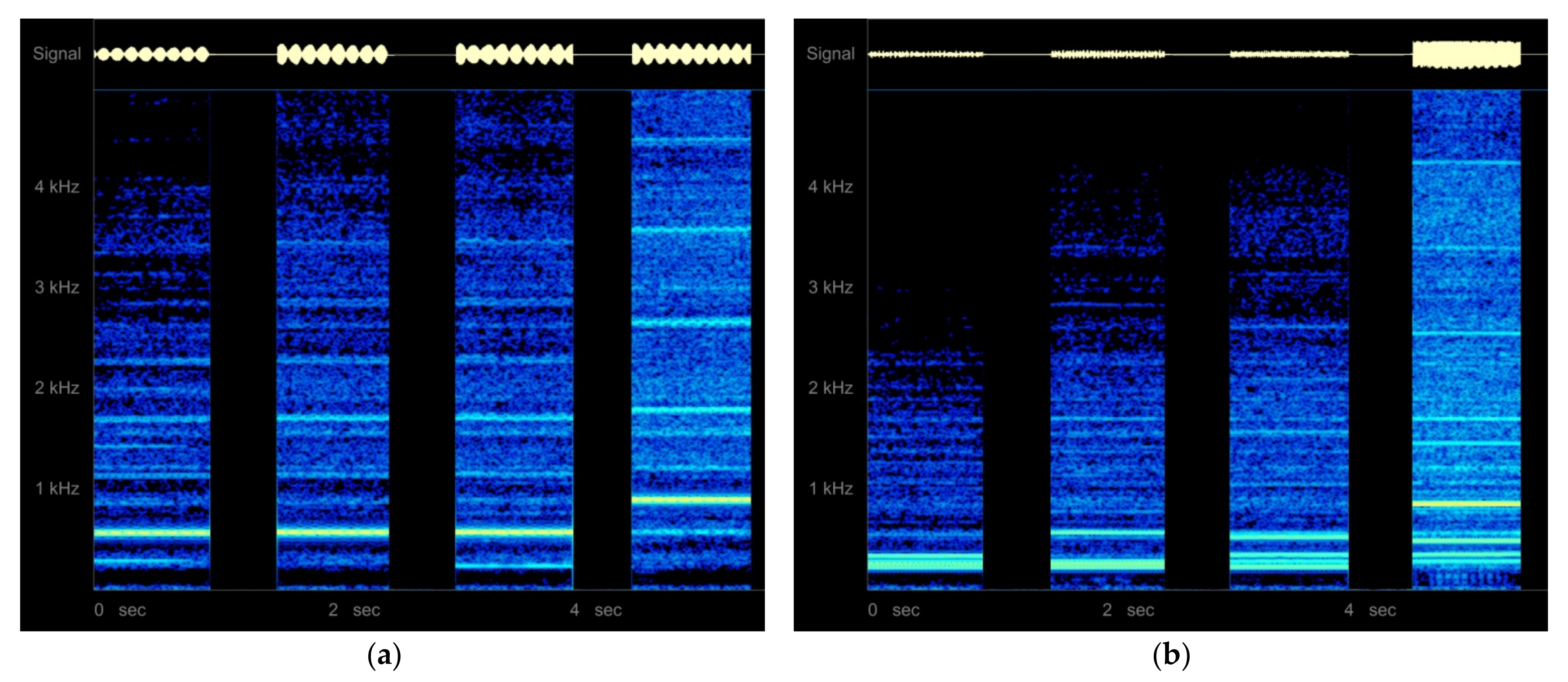





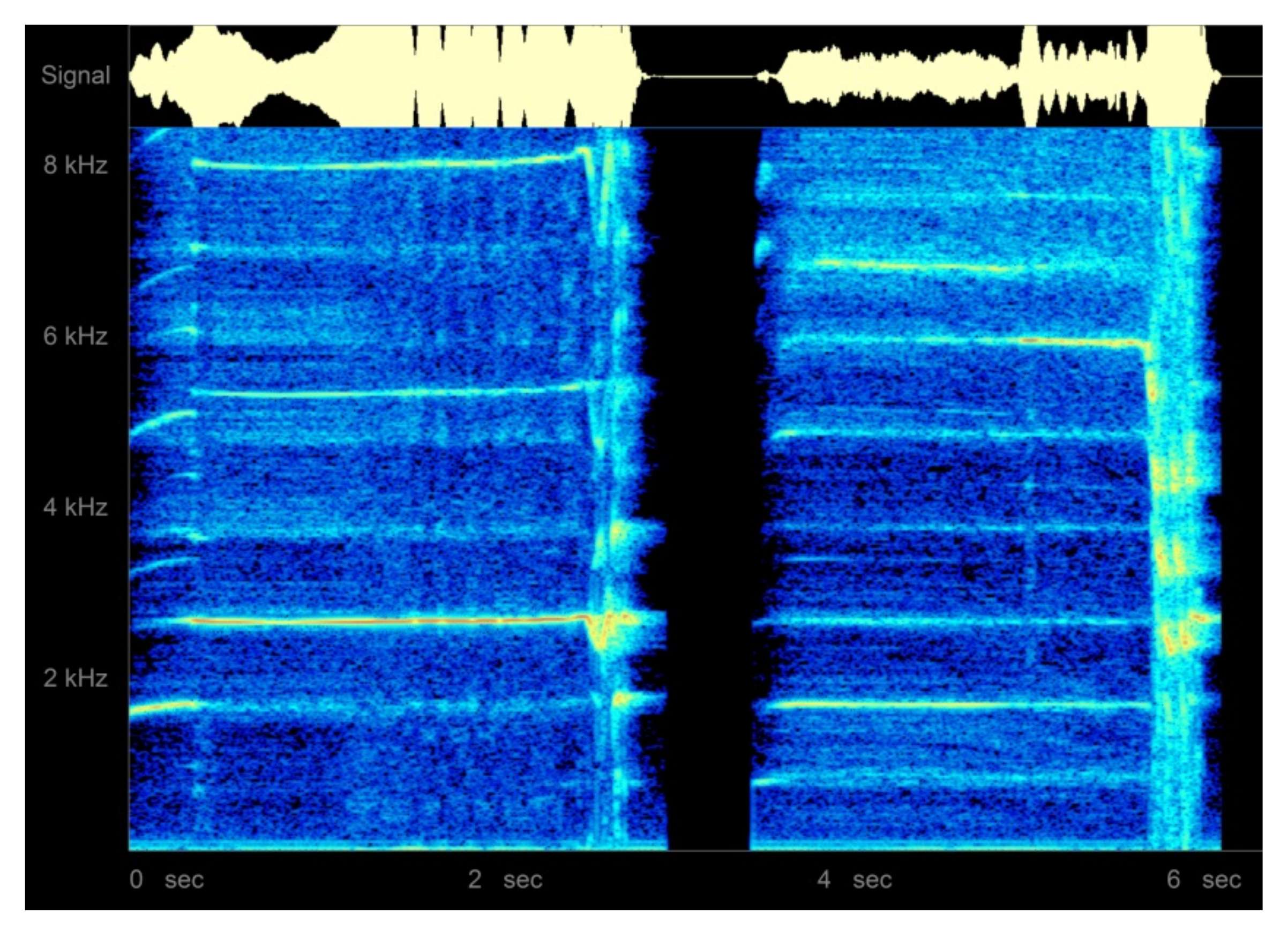

| Sound Producing Instrument | Playing Technique | Frequency Rates (Fundamental Tones) | Tonal Deviation | Sound Pressure Level at 1 m (Max. Values) |
|---|---|---|---|---|
| Shell horn, large Triplofusus princeps (MNA, Inv. 10-223548, 35.8 cm) | lip-vibration, low blowing pressure | 263–265 Hz | C4+9/+22 | Not measured |
| lip-vibration, low blowing pressure, hand-insertion technique | Not measured | |||
| Shell horn, large Triplofusus princeps (experimental model, 35.5 cm) | lip-vibration, low blowing pressure | 324–327 Hz | E4−30/−14 | 108.6–111.5 dBA |
| lip-vibration, low blowing pressure, hand-insertion technique | 265–270 Hz | C4+22 to C#4−45 | 95.6–97.8 dBA | |
| Flat mouthpiece, lip-vibration, overblown (one regime) | 1057 Hz | C6+17 | 109.6–110.3 dBA | |
| Ceramic cup-shaped mouthpiece, lip-vibration, low blowing pressure | 324–329 Hz | E4−30/−3 | 106.5–108.8 dBA | |
| Ceramic cup-shaped mouthpiece, lip-vibration, overblown (six regimes) | 539 Hz; 587 Hz; 635 Hz; 698 Hz; 741 Hz; 789 Hz | C#5−49 (lowest); G5+11 (highest) | 103.1–106.5 dBA | |
| Shell horn, small Aliger gigas (experimental model, 9.5 cm) | lip-vibration, low blowing pressure | 598–615 Hz | D5+31 to D#5−20 | 98.5–101.1 dBA |
| lip-vibration, low blowing pressure, hand-insertion technique | 505–522 Hz | B4+39 to C5−4 | 95.5–97.2 dBA |
| Teotihuacan Sound Producing Instrument | Playing Technique | Frequency Rates (Fundamental Tones) | Tonal Deviation | Sound Pressure Level |
|---|---|---|---|---|
| Ceramic horn (MNA, Inv. 10-223554, 28.3 cm) | lip-vibration, low blowing pressure | 273–280 Hz | C#4−26/+18 | Not measured |
| lip-vibration, low blowing pressure, hand-insertion technique | 246–248 Hz | B3−7/+7 |
| Teotihuacan Sound Producing Instrument | Playing Technique | Frequency Rates (Fundamental Tones) | Tonal Deviation | Sound Pressure Level at 1 m (Max. Values) |
|---|---|---|---|---|
| Ceramic trumpet, large (experimental model, 30.5 cm) | lip-vibration, different blowing pressure levels | 294–320 Hz | D4+2 to D#4+49 | 100.5–105.1 dBA |
| lip-vibration, low blowing pressure, partially hand stopping the bell | 285 Hz | C#4+48 | 96.1–97.4 dBA | |
| Ceramic trumpet, small (experimental model, 26.0 cm) | lip-vibration, different blowing pressure levels | 389–409 Hz | G4−13 to G#4−26 | 97.2–99.7 dBA |
| lip-vibration, low blowing pressure, partially hand stopping the bell | 369 Hz | F#4−5 | 96.6–98.7 dBA |
| Teotihuacan Sound Producing Instrument | Playing Technique | Frequency Rates (Fundamental Tones) | Tonal Deviation | Sound Pressure Level |
|---|---|---|---|---|
| Quadruple flute, large (MNA, Inv. 10-223540, 74.5 cm) | Pipe A, fingerholes 1–3 stopped, low blowing pressure fluctuation | 233–243 Hz | A#3−1 to B3−28 | Not measured |
| Pipe A, fingerholes 1–2 stopped, low blowing pressure fluctuation | 296–312 Hz | D4+14 to D#4+5 | ||
| Pipe A, fingerhole 1 stopped, low blowing pressure fluctuation | 325–355 Hz | E4−24 to F4+28 | ||
| Pipe A, all fingerholes open, low blowing pressure fluctuation | defect | |||
| Pipe A, all fingerholes open, overblown, different blowing pressure levels (4 regimes) | 454–522 Hz; 742–768 Hz; 790–835 Hz; 1037–1062 Hz | A#4−46 to C5−4; F#5+5 to G5−36; G5+13 to G#5+9; C6−16/+25 | ||
| Pipe B, fingerholes 1–3 stopped, lower blowing pressure fluctuation | 227–242 Hz | A#3−46 to B3−35 | ||
| Pipe B, fingerholes 1–2 stopped, low blowing pressure fluctuation | 295–299 Hz | D4+8/+31 | ||
| Pipe B, fingerhole 1 stopped, low blowing pressure fluctuation | 348–355 Hz | F4−6/+28 | ||
| Pipe B, all fingerholes open, low blowing pressure fluctuation | 377–399 Hz | F#4+32 to G4+31 | ||
| Pipe B, all fingerholes open, overblown (2 regimes) | 482–485 Hz; 1040–1042 Hz | B4−42/−31; C6−11/−7 | ||
| Pipe C, low blowing pressure fluctuation | 250–256 Hz | B3+21 to C4−38 | ||
| Pipe D | defect |
| Teotihuacan Sound Producing Instrument | Playing Technique | Frequency Rates (Fundamental Tones) | Tonal Deviation | Sound Pressure Level at 1 m (max. Values) |
|---|---|---|---|---|
| Quadruple flute, large “Zacuala Palace” (experimental model, 66.0 cm) | Straight, all holes stopped (except tone holes in pipes A–B), lower blowing pressure | 215/255/329 Hz | A3 −40/C4 −44/E4 −3 | 69.8–74.1 dBA |
| Straight, all holes stopped, overblown (4 regimes) | 220/264/555 Hz; 474/569 Hz; 474/535/880 Hz; 474/535/880/1208 Hz | A3/C4 +16/C#5 +2 (lowest); A#4 +29/C5 +38/A5/D6 +48 (highest) | 89.6–90.7 dBA | |
| Straight, all holes open, lower blowing pressure | 264/303/407 Hz | C4 +16/D#4 −46/G#4 −35 | 75.7–78.0 dBA | |
| Straight, all holes open, overblown (4 regimes) | 424/516/593 Hz; 522/605/955 Hz; 614/757/974 Hz; 772/908/958 Hz | G#4 +36/C5 −24/D5 +17 (lowest); G5 −27/A#5 −46/A#5 +47 (highest) | 92.9–97.0 dBA | |
| Quadruple flute, small “Anahuacalli 1” (experimental model, 46.0 cm) | Straight, all holes stopped, lower blowing pressure | 311/393/436 Hz | D#4 −1/G4 +4/A4 −16 | 69.1–71.8 dBA |
| Straight, all holes stopped, overblown (3 regimes) | 400/441/653/836 Hz; 665/800/857 Hz; 820/873/1081/1309 Hz | G4 +35/A4 +4/E5 −17/G#5 +11 (lowest); G#5 −22/A5 −14/C#6 −44/E6 −13 (highest) | 92.7–95.6 dBA | |
| Straight, all holes open, lower blowing pressure | 376/470/617 Hz | F#4 +28/A#4 +14/D#5 −15 | 71.2–77.6 dBA | |
| Straight, all holes open, overblown (3 regimes) | 488/620/738 Hz; 632/747/931 Hz; 946/1099/1410 Hz | B4 −21/D#5 −6/F#5 −5 (lowest); A#5 +25/C#6 −15/F6 +16 (highest) | 93.1–98.6 dBA |
| Teotihuacan Sound Producing Instrument | Playing Technique | Frequency Rates (Fundamental Tones) | Tonal Deviation | Sound Pressure Level at 1 m (Max. Values) |
|---|---|---|---|---|
| Piston whistle (MNA, Inv. 10-223558, 19.6 cm) | Low blowing pressure | Not measured | Not measured | |
| Overblowing (8 steps) | 3394 Hz; 3403 Hz; 3533 Hz; 3567 Hz; 3607 Hz; 3637 Hz; 3681 Hz; 4441 Hz | G#7+37 (lowest); C#8+2 (highest) | ||
| Overblowing, descending glissando movement (3 alternating steps) | 3753 > 3294 Hz <> 2763 > 2245 Hz <> 1774 > 1575 Hz | A#7+11 > G#7−15 <> F7−19 > C#7+21 <> A6+14 > G6+8 | ||
| Overblowing, ascending glissando movement (2 alternating steps) | 1611 < 1804 Hz <> 2347 < 2589 Hz; 2468 < 2776 Hz <> 3415 < 3644 Hz | G6+47 < A6+43 <> D7−2 < E7−32 <> D#7−15 < F7−11 <> G#7+48 < A#7−40 | ||
| Piston whistle, small (experimental model, 17.0 cm) | Low blowing pressure (key note) | 742–754 Hz | F#5+5/+32 | 54.3–74.9 dBA |
| Overblowing (6 steps) | 1620 Hz; 2378 Hz; 2671 Hz; 2795 Hz; 4947 Hz; 5961 Hz | G#6−43 (lowest); F#8+12 (highest) | 93.4–105.7 dBA | |
| Overblowing, descending glissando movement (4 alternating steps) | 5961 > 5268 <> 4848 > 4192 <> 3586 > 3228 <> 2758 > 2325 | F#8+12 > E8−2 <> D#8−46 > C8+2 <> A7+32 > G7+50 <> F7−22 > D7−18 | ||
| Overblowing, ascending glissando movement (2 alternating steps) | 2362 < 2754 Hz <> 3433 < 3812 Hz | D7+9 < F7−25 <> A7−43 < A#7+38 |
Publisher’s Note: MDPI stays neutral with regard to jurisdictional claims in published maps and institutional affiliations. |
© 2021 by the author. Licensee MDPI, Basel, Switzerland. This article is an open access article distributed under the terms and conditions of the Creative Commons Attribution (CC BY) license (https://creativecommons.org/licenses/by/4.0/).
Share and Cite
Both, A.A. Sonic Artefacts of Teotihuacan, Mexico (Horns, Trumpets and Pipes). Acoustics 2021, 3, 507-544. https://doi.org/10.3390/acoustics3030034
Both AA. Sonic Artefacts of Teotihuacan, Mexico (Horns, Trumpets and Pipes). Acoustics. 2021; 3(3):507-544. https://doi.org/10.3390/acoustics3030034
Chicago/Turabian StyleBoth, Arnd Adje. 2021. "Sonic Artefacts of Teotihuacan, Mexico (Horns, Trumpets and Pipes)" Acoustics 3, no. 3: 507-544. https://doi.org/10.3390/acoustics3030034
APA StyleBoth, A. A. (2021). Sonic Artefacts of Teotihuacan, Mexico (Horns, Trumpets and Pipes). Acoustics, 3(3), 507-544. https://doi.org/10.3390/acoustics3030034




